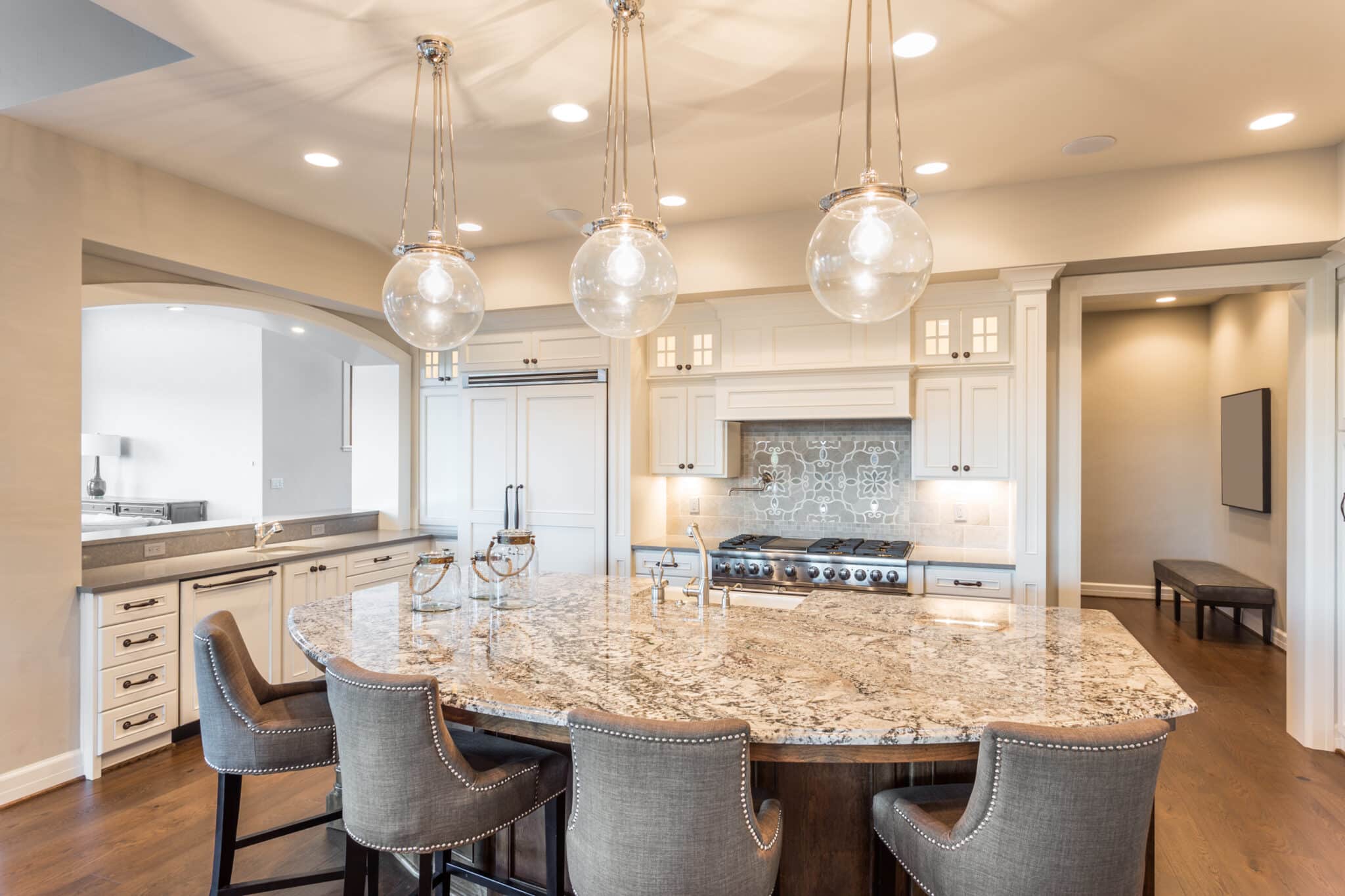When it comes to enhancing your kitchen’s functionality and ambiance, understanding kitchen lighting circuits is key. Many homeowners in Lancaster, PA, are discovering the transformative power of well-designed lighting plans. These circuits not only illuminate your space but also highlight your kitchen’s best features, making every corner inviting and practical for various tasks. With the right approach, you can achieve a balance of style and efficiency that elevates your kitchen experience.
Designing kitchen lighting circuits requires a thoughtful consideration of both form and function. In York, PA, residents often seek lighting solutions that blend seamlessly with their kitchen’s overall design while providing ample light for cooking, dining, and entertaining. This means integrating a mix of task, ambient, and accent lighting to create a warm and welcoming atmosphere. By focusing on these elements, you can craft a lighting scheme that meets all your needs.
However, the process of implementing kitchen lighting circuits can seem daunting without the right guidance. It’s not just about choosing stylish fixtures, it’s also about understanding the technical aspects, such as wiring and placement, to ensure your kitchen is safe and well-lit. Fortunately, with expert advice and careful planning, homeowners can navigate these challenges successfully. The goal is to create a lighting plan that looks good and functions flawlessly.
Ultimately, the success of kitchen lighting circuits lies in their ability to enhance both the aesthetics and functionality of your kitchen. Whether you’re in Lancaster, PA, or York, PA, the principles remain the same: combine strategic planning with quality fixtures to achieve the best results. By doing so, you’ll not only improve your kitchen’s appeal but also its usability, making it a joy to cook, dine, and gather in.
Understanding the Basics of Kitchen Lighting Circuits
To truly appreciate the impact of kitchen lighting circuits, one must first grasp the basics. These circuits serve as the electrical backbone, powering all the lighting fixtures in your kitchen. Properly designed, they ensure that each light functions optimally, without overloading the system. In Lancaster, PA, homeowners prioritize safety and efficiency, making a well-planned circuit essential.
Understanding different types of lights is crucial in this process. Task lighting, for example, focuses on work areas, making food preparation safer and more enjoyable. Ambient lighting, on the other hand, fills the room with a soft glow, creating a welcoming environment. Meanwhile, accent lighting highlights architectural features or decor, adding depth and interest to the space.
The placement of these lights plays a significant role in the overall effectiveness of kitchen lighting circuits. Strategic positioning ensures that work areas are well-lit, without casting shadows or creating glare. In York, PA, professionals often recommend under-cabinet lights for tasks and recessed lighting for ambient illumination. This approach not only enhances functionality but also elevates the kitchen’s aesthetic appeal.
Lastly, the technical side of kitchen lighting circuits cannot be overlooked. It involves understanding wattage, voltage, and the capacity of your home’s electrical system. Homeowners are advised to consult with a professional to ensure their plans align with safety standards and regulations. This collaboration guarantees that your kitchen lighting is not only beautiful but also safe and reliable, making every moment in the kitchen enjoyable.

Planning Your Kitchen Lighting Layout
Planning your kitchen lighting layout is a step that requires careful consideration and an eye for detail. In Lancaster, PA, homeowners often start by identifying key areas that need illumination. This includes countertops, sinks, and any islands or dining areas. By pinpointing these spots, you can ensure that task lighting is effectively positioned to enhance functionality without creating unwanted shadows.
Next, incorporating ambient lighting into your kitchen lighting circuits can transform the overall mood of the space. This type of lighting softens the room, filling it with a warm glow that invites people in. To achieve this, homeowners might consider installing overhead fixtures or recessed lighting. These options distribute light evenly, eliminating harsh contrasts and promoting a welcoming atmosphere.
Accent lighting is another crucial component that adds depth and dimension to your kitchen. It’s perfect for showcasing beautiful architectural features or prized possessions on display. In York, PA, designers often suggest installing strip lights under cabinets or spotlights on artwork. Such strategic placements not only highlight key elements but also contribute to the layered lighting effect that makes a kitchen feel complete.
Finally, understanding the technical requirements of kitchen lighting circuits is paramount. This involves calculating the total wattage needed and ensuring your circuit can handle the load. It’s wise to consult with a professional electrician who can offer guidance and ensure your lighting plan meets all safety standards. With their help, you can create a well-lit kitchen that’s both beautiful and functional, making every cooking and dining experience a pleasure.
Types of Lights for Your Kitchen Circuits
Choosing the right types of lights for your kitchen circuits is essential for achieving both functionality and ambiance. In Lancaster, PA, homeowners often start with task lighting, which is crucial for cooking and preparation areas. This lighting ensures that countertops and stovetops are well-lit, reducing the risk of accidents and making meal prep easier. LED strip lights or adjustable spotlights are popular choices, offering bright, focused illumination where it’s needed most.
Ambient lighting, on the other hand, plays a key role in creating a welcoming atmosphere in your kitchen. This softer, more diffused light fills the room, eliminating shadows and providing a uniform level of brightness. In York, PA, many opt for flush mounts or chandeliers that add character while evenly lighting the space. These fixtures work in harmony with natural light sources to maintain a comfortable environment throughout the day.
Accent lighting adds depth and interest to your kitchen, highlighting architectural features or artwork. This type of lighting can transform ordinary cabinets and shelves into display pieces, showcasing your favorite dishes or glassware. Installing under-cabinet LEDs or directional track lights can accentuate textures and colors, bringing your kitchen’s design to life. It’s an effective way to personalize the space and create visual focal points.
Finally, integrating these lighting types into your kitchen lighting circuits requires careful planning and consideration of your home’s electrical capacity. Consulting with a professional electrician ensures that your lighting design is not only aesthetically pleasing but also safe and compliant with local regulations. They can help you balance the load on your circuits, preventing overloads and ensuring that your kitchen remains a safe, welcoming space for cooking, dining, and gathering.
Incorporating Task Lighting in Your Kitchen
Incorporating task lighting into your kitchen lighting circuits significantly enhances the functionality of the space. Homeowners in Lancaster, PA, find that adding under-cabinet lighting not only brightens countertops but also makes reading recipes and preparing meals easier. By carefully selecting LED options, you can achieve a high level of illumination without excessive energy consumption. This strategic addition ensures that your kitchen is both practical and inviting, catering to all your culinary needs.
Ambient and accent lighting, while essential for atmosphere, should complement the task lighting to create a balanced and cohesive look. In York, PA, residents often combine various light sources to achieve this harmony. For example, a well-placed pendant light can add warmth to the room while working in tandem with under-cabinet lights to illuminate tasks areas efficiently. This layered approach to kitchen lighting circuits ensures that every corner of your kitchen is perfectly lit, enhancing both form and function.
Consulting with a professional electrician is a crucial step in integrating task lighting into your kitchen. They can provide valuable insights into the best types of fixtures for your specific needs and help design a circuit that accommodates them. Their expertise ensures that your kitchen lighting is not only beautiful but also meets all safety standards. This partnership guarantees that your lighting upgrade is a success, offering peace of mind along with improved visibility.
Finally, the beauty of a well-planned kitchen lighting circuit lies in its ability to adapt to the evolving needs of your space. Whether you’re hosting a dinner party in Lancaster, PA, or enjoying a quiet evening at home, the right lighting can set the mood and make your kitchen a more versatile and enjoyable space. By focusing on task lighting and consulting professionals, you can create a lighting scheme that truly transforms your kitchen, making it a centerpiece of your home.
The Role of Ambient Lighting in Kitchen Design
Understanding the role of ambient lighting in kitchen design is crucial for homeowners in Lancaster, PA, aiming to create a welcoming and functional space. This type of lighting softens the edges and fills the kitchen with a gentle glow, making it appear more spacious and inviting. By integrating ambient lighting into kitchen lighting circuits, you ensure that the space is comfortable for both cooking and socializing. It acts as the backdrop to your kitchen’s atmosphere, complementing task and accent lighting for a cohesive look.
In York, PA, ambient lighting is often achieved through the use of ceiling-mounted fixtures, like flush mounts or chandeliers, that provide a uniform light distribution. These fixtures work in harmony with natural light during the day and become the primary light source at night. Choosing dimmable options allows for flexibility, enabling homeowners to adjust the lighting according to the time of day or the mood they wish to create. This adaptability makes ambient lighting a key element in the design of kitchen lighting circuits.
Furthermore, the strategic placement of ambient lighting can enhance the functionality of kitchen lighting circuits without overwhelming the space. For instance, installing a central fixture in conjunction with softer, peripheral lights can illuminate the entire kitchen evenly. This approach minimizes shadows and glare, making every corner of the kitchen usable and safe. It’s a subtle yet effective way to enhance the kitchen’s design and usability.
Lastly, consulting with a professional electrician can help homeowners in Lancaster, PA, and York, PA, maximize the benefits of ambient lighting in their kitchen lighting circuits. They can offer advice on the best fixtures and placements to achieve a warm and welcoming atmosphere. Their expertise ensures that the ambient lighting not only looks good but also operates efficiently within the kitchen’s overall lighting plan. This collaboration leads to a well-lit, inviting kitchen space that meets all the homeowner’s needs.
Adding Accent Lighting to Highlight Kitchen Features
Accent lighting serves as the finishing touch in a well-designed kitchen, drawing attention to the beautiful features and enhancing the overall ambiance. In Lancaster, PA, homeowners incorporate this type of lighting to spotlight unique architectural elements, artwork, or exquisite cabinetry. By strategically placing accent lights, they can create focal points that not only elevate the kitchen’s design but also add depth to the space. This approach ensures that kitchen lighting circuits not only fulfill their functional role but also contribute to the aesthetic appeal of the home.
In York, PA, the use of LED strip lights under cabinets or directional spotlights over islands is a popular choice for adding layers of light. These options offer precise control over the lighting effect, allowing homeowners to highlight specific areas for dramatic impact. Accent lighting, when integrated into kitchen lighting circuits, provides the flexibility to customize the mood and atmosphere of the kitchen. It’s a versatile tool that can transform the space from a bustling area for meal prep to a serene spot for evening relaxation.
Consulting with a professional electrician is crucial when adding accent lighting to kitchen lighting circuits. They can advise on the best fixtures and placements to achieve the desired effect without compromising on safety or efficiency. Their expertise ensures that the accent lighting works in harmony with other lighting types, creating a balanced and cohesive look. This guidance is invaluable in achieving a kitchen that is not only functional but also visually stunning.
Ultimately, the goal of incorporating accent lighting into kitchen lighting circuits is to enhance the beauty and functionality of the space. It allows homeowners to showcase their personal style and make their kitchen a true centerpiece of the home. Whether it’s illuminating a prized collection of pottery or casting a warm glow over a stone backsplash, accent lighting adds that special touch that makes a kitchen unique. This thoughtful integration of lighting elevates the everyday experience, making the kitchen not just a place for cooking, but a sanctuary for creativity and comfort.

Smart Tips for Kitchen Lighting Circuit Installation
Installing kitchen lighting circuits requires careful planning to ensure both functionality and aesthetic appeal. In Lancaster, PA, homeowners often start by consulting with a professional electrician. This step is crucial for understanding the specific requirements of their kitchen space. It ensures that the lighting plan is both safe and effective, meeting the homeowner’s needs.
One smart tip is to consider the layout of your kitchen carefully. This includes the placement of appliances, cabinets, and work areas. In York, PA, electricians recommend creating a detailed plan that outlines where each light should go. This approach minimizes the risk of poorly lit areas and maximizes the efficiency of the lighting circuit.
Another important aspect is choosing the right fixtures for each area of the kitchen. Task lighting should be bright and focused, while ambient lighting can be softer and more diffuse. Accent lighting, on the other hand, requires fixtures that highlight specific features without overwhelming the space. Selecting the correct type of lighting for each area enhances the kitchen’s functionality and ambiance.
Finally, incorporating dimmers into kitchen lighting circuits offers flexibility in controlling the atmosphere of the space. Dimmers allow homeowners to adjust the lighting based on the time of day or the task at hand. This not only saves energy but also extends the life of the lighting fixtures, making the kitchen a more adaptable and enjoyable space.
Energy Efficiency and Kitchen Lighting Circuits
Incorporating energy efficiency into kitchen lighting circuits not only reduces utility bills but also contributes to a more sustainable home environment. Homeowners in Lancaster, PA, are increasingly opting for LED bulbs over traditional incandescent ones. These LEDs consume less power and have a longer lifespan, making them ideal for both task and ambient lighting. By choosing energy-efficient options, you can enjoy a well-lit kitchen without the high energy costs.
Another way to enhance energy efficiency in kitchen lighting circuits is through the use of motion sensors and timers. In York, PA, residents find that installing these devices helps manage lighting use more effectively. Motion sensors ensure lights are on only when the space is occupied, while timers can automatically turn lights off at a set time. This smart technology prevents unnecessary energy consumption, aligning with eco-friendly living standards.
The design of kitchen lighting circuits also plays a significant role in energy efficiency. By strategically placing lights to maximize natural daylight, homeowners can reduce the need for artificial lighting during the day. Positioning task lights under cabinets and using ambient light in central areas can illuminate your kitchen effectively with minimal energy use. This thoughtful layout not only saves on electricity but also creates a more pleasant and natural cooking environment.
Finally, consulting with a professional electrician about energy-efficient kitchen lighting circuits is a wise decision. They can offer valuable insights into the latest energy-saving technologies and how to integrate them into your kitchen design. Whether you’re in Lancaster, PA, or York, PA, their expertise ensures your lighting plan is both beautiful and beneficial to the environment. With their help, achieving an energy-efficient kitchen that meets your needs and supports sustainability becomes a straightforward process.
Frequently Asked Questions
What are kitchen lighting circuits?
Kitchen lighting circuits are the electrical pathways that power lights in your kitchen. They ensure your space is well-lit, combining safety with ambiance. By designing these circuits thoughtfully, you can highlight areas for cooking, dining, or entertaining. Properly planned, they enhance both the functionality and beauty of your kitchen.
How do I plan kitchen lighting?
To plan kitchen lighting, start by identifying key areas like countertops and islands. Consider layering with ambient, task, and accent lights for versatility. Use LED options for energy efficiency and longevity. Finally, consult with professionals like Mister Sparky to ensure your kitchen lighting circuits meet your needs and safety standards.
What are the best lights for kitchens?
The best lights for kitchens blend functionality with style. LED lights are popular for their energy efficiency and long life. Under-cabinet lighting improves visibility for tasks. Pendant lights add a touch of elegance and can illuminate central areas like islands effectively.
How many circuits are needed for kitchen lighting?
Determining the number of circuits for kitchen lighting depends on your kitchen’s size and layout. Typically, at least two circuits are recommended to separate task lighting from general illumination. This approach ensures that a trip in one circuit doesn’t plunge the entire kitchen into darkness. For a detailed plan, consulting with professionals like Mister Sparky can provide a tailored solution that meets both needs and safety codes.
Can kitchen lighting circuits be DIY installed?
Installing kitchen lighting circuits on your own can be tempting but it’s a task best left to professionals. Working with electricity requires specific knowledge and skills to ensure safety and compliance with local codes. Mister Sparky’s team has the expertise to design and implement these circuits efficiently. They ensure your kitchen is both beautifully lit and safe for everyone.






